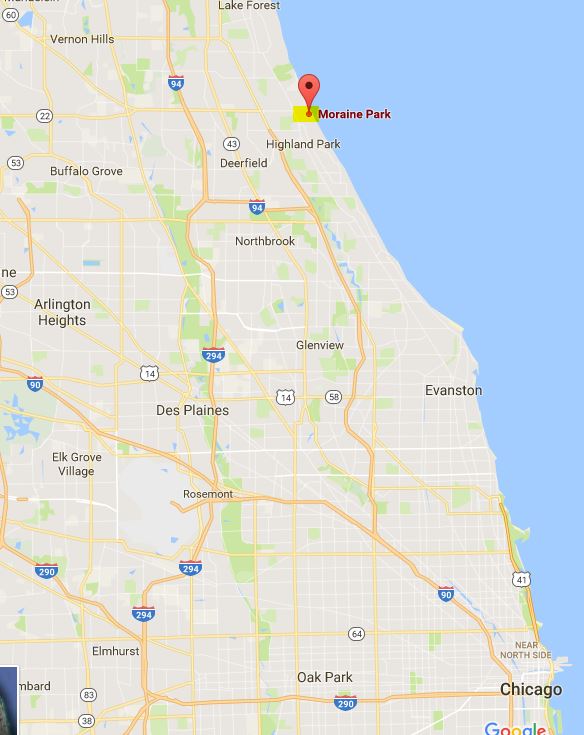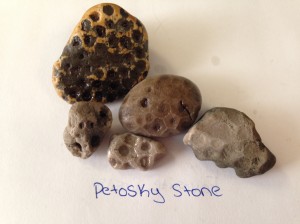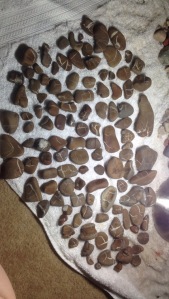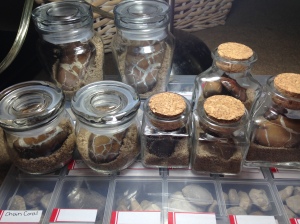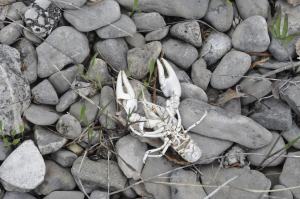The annual Tucson Gem and Mineral show is held from January 28th to February 15th give or take depending on the year. I started off my trip with almost everyone I encountered around Tucson and on the internet about how I went during the wrong time. During this time frame It was Monsoon season and the ending of the hottest time of the year. Almost everyone also had their own piece of advice about staying hydrated. Which is true, you will want to stay hydrated. I came fully prepared with a list of places I had picked up on the web to go hounding. I ended up finding out the list I had was completely useless as the sources were: from too long ago to be accurate, the temperature, the amount of actual plant life, monsoon season/flooding, Locals not providing information, and my very limited mobility since anything involving rock hounding was not something the person I went to visit wanted to do. So here I have compiled some information in regards to the places I did make it to in that week and details of what was collected, seen or encountered.
Black Hills Rock Hound Area
Specimens Found: Fire Agate, White Chalcedony
Animal encounters: Road Runner, Desert Horned Lizard, Cattle
I was able to come home with several pieces of the weirdest shaped white chalcedony and some pieces of fire agate. Those I was able to locate at the Black Hills Rock Hound Area. Several locals indicated that it was a well picked over area, but because I went outside the season to collect, I did not see a single soul when I went out there. It was actually quite peaceful. I stopped at a little side lot before the actual Black Hills site because the steep hill into a dry wash before the lot would not have been very nice to the small car I was driving. I feel on that little car lot I found a lot more fire agate and white chalcedony then up at the designated spot! You will find a very large amount of smaller pieces all over the ground but if you want to find larger pieces you will have to dig. I wasnt able to find huge pieces of fire agate but I did find very large pieces of the chalcedony which are still very cool to look at. I would like to add it is a very beautiful area, you will encounter roaming cattle and I did see a desert horned lizard who was very mellow and was just hanging out with me as I dug. The little side lot I mentioned may be more inaccessible in the true rockhounding months since I saw a lot of little camp fires around, so that might be a prime spot for individuals to camp since it is free and allowed in that area. I want to also note, that if you are to travel to this location there is some misinformation on the web. Several sites state that the BLM is on site and gives the address. The BLM is about 30 minutes from the rock hound area. The address took me all the way to the BLM for them to give me a map to back track to the location.
Tanque Verde Falls
Minerals Found: Tri-Color Calcite, Blue Calcite, Mica
Animals Encountered: Desert Horned Lizard, Snake, Lizard
Another location I was able to collect at was near Tanque Verde Falls outside of Tucson. I found several nice looking pieces of blue chalcedony, and I kid you not I found some Tri-Color Calcite, which I was not aware of it being in that area. When you get to the several pools in the falls, you can pick up rocks under the water as you bask in his very calm and isolated waters. Most of the pieces were your typical quartz but all of them had large amounts of Mica. When sitting in the pools you can see glitter just floating all around, the pools glittered. This hike was not very long, it was less than a mile and we only encountered one individual while we were laying in the pools who informed us in the lower part of those falls off of one of the parking areas was a location with nice forms of calcite. The friendly local also informed us if we were to venture down the trailing waterfall there is a location where several younger folks like to go cliff jumping. Another great piece of information from the traveler was that if we were to go farther down than that we would encounter a designated nudist trail and swimming area. I am very thankful for that piece of advice so we could avoid traveling to that area. The only animals that we encountered were a black necked garter snake that was in the water, based on his ‘popularity’ on several other blogs on the internet, he seems to be a local at those waters and he just swam away from us and did not come back around. We also saw several common lizards and another desert horned lizard.
Somewhere Among The Santa Rita Mountains
Minerals found: None
Animals encountered (Alive): Cattle, Desert Hare, Beetle
After this venture we ran off to go see, what rockhounds in that area referred to as a ‘rock hounds’ dream, which was off Santa Rita Rd. It was said to go about 12 miles down this road and you would reach the small only recently known town of Helevita. You will reach the cemetery first which some individuals have taken up themselves to fix up a bit and then there is to be said to find a few small remains of buildings, beyond that it is to be said that there are about 15 different mines. My adventure trying to get here was a very long one. Do not follow any sort of GPS directions, the first time we tried getting to Santa Rita RD it brought us to a different portion of it that was on private land in an orchard. When traveling down Santa Rita Road you can see that most of it is a experimental area for ASU so there are several locations with cattle or gates. in the distance you can see a very large capped mountain believed to be for salt/gypsum mining. At a point you will reach a fork in the rd to either continue left and continue right, following the very old map in the Gem Trails of Arizona we took the right (Because in the map there is no indication of left or right, the map basically shows you running into the cemetary) well later we find out the right was not the right way. And after several miles my partner revealed she forgot to get gas before we went down this long road. She made the decision to leave me behind to continue hiking for the mines while she took an hour to go to the gas station and come all the way back. I am not going to lie to you, I was very frightened because almost everything online tells you that everything is poisonous and wants to kill you. Basically could be called the United States version of Australia. I continued walking in hopes to find the cemetary at the very least but by this time I found I had no service for cell of any kind, I was in the middle of this trail that had no gps marked coordinates and a large storm cloud was moving over head. I began thinking of how many dry washes we had to go over on our way this far and since it was monsoon season I would be stuck there with no rescue. I started walking back and as I walked I passed a bush that a rattlesnake warning came from. Eventually I came in contact with my partner who had arrived back and we continued the original way I was going. We encountered a set of tracks and fresh skat from what to believed was a coyote and I did encounter some mountain lion tracks. These things were not there when she had originally left me alone and a freshly killed bird lay near. I will take this as I was spared from a couple deadly animals lurking. We got to a certain point where we believe was the cemetary but because of monsoon season there was so much foliage all we could see was what was to believed as the fence placed around it. On the other road that continued straight, it had a very long dip into a valley in the mountains and a dead-end sign marked its place. To your left we could see what I believe is a road marker of 485, there also before that was a cattle guard with some cattle staring us down. I believed that continuing down the dead end road was where the mines were but the sun was setting and we were not down to meet our new lion friend.
Mistakes in location Discovered
Later in time I tried looking up the location to see how much farther we were from the mines for my own knowledge. That search was the hardest thing I have ever done with google maps and I am still not sure where we were, my phone indicates that the pictures I took were down road 411 but I am not 100% confident that is where it was taken just because I had no service. I cannot find any indication of what mountains they were or find any related images. It really is bothering me more than it should. I am pretty sure based on what I have found is that when we took the right turn the left turn would have run us into the cemetery and several other roads. I did not find very many rocks other than purpose placed gravel, it was not that great for rocks in that area and i was deeply disappointed. But the view and my favorite picture of the trip did make most of that confusing journey worth it. I got to see several cute huge eared desert hares and this super strange beetle that was walking around like a spider.
Tucson Gem and Mineral World
Specimens Purchased: Fulgerite, Olenoide, Helundite, other trilbite
On the hottest day of that week I was to stay, we went to a movie and after wards my hostess’ took me to the Tucson Gem and Mineral world, all I want to say is ‘WOW’. This places had thousands of specimens, you could easily spend hours in this place. The store is actually pretty small and cramped but most of the pieces are in cases and mounted. A lot of them I could see were at one time museum specimens. Under every glass case were several wooden drawers which also had specimens, unfortunately my hostess’ were not interested in minerals at all and I felt I was taking up too much of their time to spend the amount of time I would have prefered. They had everything and one thing I forgot to purchase was a dinosaur bone. I kid you not when I say they had everything including things I questioned how I would legally get it back home such as Uranium Ore. Also, there were cabinets full of specimens from India including some amazing stillbite (kind of one of my mineral obsessions) and all of the specimens from India were 50% off. I took my look around the shop and waited till I could compile a mental list of what I wanted to see out of the case since I didn’t want to waste owners time. He guided me through the store letting me see everything I desired. I don’t say this much but this is one of the nicest people I have met in the rock hound community. From what I could see he was the owner and the other two that were working was his son and then granddaughter, and I love local generational business’! I received the piece of Heludenite that was a steal and I walked him to the Olenoide that I was drooling over, he knew I had a attraction to this piece and gave me the biggest deal of a life time, I almost started crying, he handed me the specimen and asked if I wanted him to bring it up front. I informed him I wanted to carry it and it followed with. Him: You are shaking . Me: Because I’m just so happy
I also picked up a beautiful specimen of Fulgerite that was found by a local woman nearby. When checking out I gave him some of my art work (I print them off as stickers) as a thank you for the amazing service and the gifts. He then came back out with two additional trilobite pieces and said “You gave me a gift now I will give you one” I was speechless and when I originally objected saying the stickers were a gift because of the deals he gave me he told me to be quiet and not look a gift horse in the mouth. This is hands down the best mineral shopping experience in my life.
Reyes Mineral Shop
Specimens Purchased: Snake Skin Agate, Montana Agate
I also went to one other location which was Reyes mineral shop outside of Benson, he had several specimens but it was not that large of a location but I did observe the several pieces of lapidary equipment he had for sale. I had just came out of a massive rain storm where people were close to dying so I was trying to engage him in nervous conversation, he seemed short at first but then warmed up and gave me some advice on places to look at and some of the places I had mapped but was thinking of going to. I bought a snake skin Agate and a Montana agate as things I did not have in my specimen cabinet yet and he has well gave me them at a very low price.
